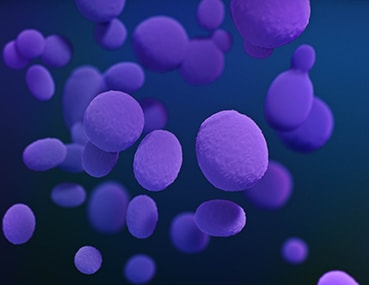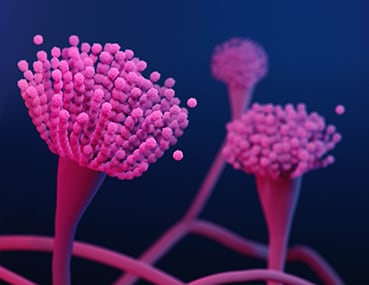Antifungal Resistance
Fungal infections that resist treatment are a challenge to the public’s health.

Medical illustration of Candida spp., presented in CDC’s Antibiotic Resistance Threats in the United States, 2019.
The problem
Antifungal drugs treat fungal infections by killing or stopping the growth of dangerous fungi in the body. Fungi, like bacteria, can develop antibiotic resistance, when germs like bacteria and fungi develop the ability to defeat the drugs designed to kill them. Antifungal resistance occurs when fungi no longer respond to antifungal drugs.
Only three types of antifungal drugs currently exist, so antifungal resistance can severely limit treatment options. Some types of fungi, like Candida auris, can become resistant to all three drug types.1 Resistance is especially concerning for patients with invasive fungal infections—severe infections that affect the blood, heart, brain, eyes, or other parts of the body—because these are serious infections that may be more difficult to treat if they are resistant and if antifungal treatment is limited. For example, bloodstream infections with the fungus Candida (a yeast) that are resistant to treatment can cause serious health problems, including disability and death.
What causes antifungal resistance?
Some species of fungi are naturally resistant to treatment with certain types of antifungal drugs. For example, the drug fluconazole does not work against infections caused by the fungus Aspergillus, a type of mold. Resistance can also develop over time when fungi are exposed to antifungal drugs. This resistance can occur when antifungal drugs are used improperly to treat sick people (e.g., when dosages are too low, or when treatment courses are not long enough), or even when antifungal drugs are used properly.2,3 Use of fungicides in agriculture to prevent and treat fungal diseases in crops can also contribute to resistance in people exposed to those fungicides.
Some studies have indicated that antibiotics —which include antifungal drugs—may also contribute to antifungal resistance in Candida. This resistance could occur in a variety of ways. For example, antibiotics can reduce good and bad germs in the gut, which creates favorable conditions for Candida growth.4 It is not known if decreasing the use of all or certain antibiotics can reduce Candida infections, but appropriate use of antibiotics and antifungal drugs is one of the most important factors in fighting drug resistance.
Types of resistant fungi
Fungi that have shown resistance to antifungal drugs are Aspergillus and certain Candida species. Candida auris is a new species that is particularly resistant to antifungal drugs and can spread in healthcare settings. Learn more:
Tackling antifungal resistance
Antifungal resistance is a growing threat. Everyone—from CDC researchers and laboratorians to healthcare professionals to the general public—has a role to play in preventing fungal infections and reducing antifungal resistance. Further study is needed about links between antifungal-resistant infections and agricultural fungicide use on crops before action steps can be recommended. This work complements additional CDC antibiotic resistance investments, collectively known as CDC’s Antibiotic Resistance (AR) Solutions Initiative. Through these investments, CDC is transforming how the nation combats and slows antibiotic resistance at all levels.
- CDC is:
- Conducting surveillance: Tracking antifungal resistance in Candida infections at 10 sites across the country through the Emerging Infections Program (EIP).
- Expanding lab capacity: Supporting a network of regional public health laboratories through the Antibiotic Resistance Laboratory Network (AR Lab Network) to detect resistant fungi and perform antifungal susceptibility testing.
- Using state-of-the-art lab technology: Using genetic sequencing and developing new laboratory tests to identify and understand specific mutations associated with antifungal resistance.
- Using data for action: Summarizing antifungal prescribing patterns across healthcare facilities and promoting appropriate use of antifungal drugs.
- Supporting surveillance globally: Through collaborations with the World Health Organization’s (WHO’s) Global Antimicrobial Resistance Surveillance System (GLASS), CDC continues to support increased detection and tracking of antibiotic resistance to prevent illnesses and save lives.5
- Healthcare facility leadership and infection control staff can:
- Assess antifungal use as part of their antibiotic stewardship programs.
- Ensure adherence to infection prevention and control guidelines, including proper hand hygiene.
- Doctors and other hospital personnel can:
- Prescribe antifungal drugs appropriately and document the dose, duration, and indication for every antifungal prescription.
- Test for antifungal resistance in patients with invasive disease who are not improving with first-line antifungal drugs.6,7
- Be aware of resistance patterns, including antifungal resistance, in their facility and community.
- Follow hand hygiene and other infection prevention and control guidelines with every patient.
- Hospital patients can:
- Clean their hands.
- Be sure everyone cleans their hands before entering the room.
- Ask each day if a catheter is necessary, if the patient has one.
- Talk to their healthcare provider about their risk for certain infections, especially if the patient has a weakened immune system.
- Take antifungal drugs only when needed and exactly as prescribed.
- Talk to their doctor if they experience side effects or if the antifungal drugs they are taking are not treating symptoms.
Related Links
- CDC Expert Commentary on Medscape: The Rise in Antifungal Resistance
- CDC – Antibiotic Resistance Threats in the United States, 2019[PDF – 148 pages]
- CDC – Candida auris
- CDC – Central Line-associated Bloodstream Infection (CLABSI)
Antibiotic Stewardship and Infection Control
References
- Ostrowsky B, Greenko J, Adams E, Quinn M, O’Brien B, Chaturvedi V , et al. Candida auris isolates resistant to three classes of antifungal medications — New York, 2019. MMWR Morb Mortal Wkly Rep 2020;69:6–9
- Lortholary O, Desnos-Ollivier M, Sitbon K, Fontanet A, Bretagne S, Dromer F, et al. Recent exposure to caspofungin or fluconazole influences the epidemiology of candidemia: a prospective multicenter study involving 2,441 patients. Antimicrob Agents Chemother 2011;55:532–8.
- Shah DN, Yau R, Lasco TM, Weston J, Salazar M, Palmer HR, et al. Impact of prior inappropriate fluconazole dosing on isolation of fluconazole-nonsusceptible Candida species in hospitalized patients with candidemia. Antimicrob Agents Chemother 2012;56:3239–43.
- Ben-Ami R, Olshtain-Pops K, Krieger M, Oren I, Bishara J, Dan, M, et al. Antibiotic exposure as a risk factor for fluconazole-resistant Candida bloodstream infection. Antimicrob Agents Chemother 2012;56:2518–23.
- WHO: Global Antimicrobial Resistance Surveillance System (GLASS)
- Patterson TF, Thompson GR, 3rd, Denning DW, Fishman JA, Hadley S, Herbrecht R, et al. Practice guidelines for the diagnosis and management of aspergillosis: 2016 update by the Infectious Diseases Society of America. Clin Infect Dis 2016;63:e1–60.
- Pappas PG, Kauffman CA, Andes DR, Clancy CJ, Marr KA, Ostrosky-Zeichner L, et al. Clinical practice guideline for the management of candidiasis: 2016 update by the Infectious Diseases Society of America. Clin Infect Dis 2016;62:e1–50.
























.png)











No hay comentarios:
Publicar un comentario